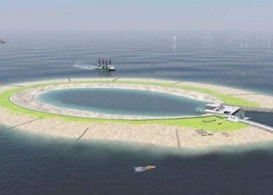One of the largest hurdles facing renewable energy is intermittency. Renewable energy is often available during off-peak hours or only during parts of the day. Both situations seem to require some sort of storage in order to balance the load and provide a continual electricity supply. 
Belgium has side-stepped the battery issue in their plans for a pump-storage “battery” island near their offshore wind farms in the North Sea. The island is planned to be 3 km in diameter and will be located around 4 km off the coast of West Flanders. The project is slated to be completed in the next five years and will consist of a horseshoe-shaped island with a large central water reservoir. Upon completion, the island would use excess electricity generated from the wind farm to pump water out of the reservoir. The energy is recovered again later when water is released back into the reservoir through a hydro power plant at the end of one of the horseshoe legs. The pump-storage technique is traditionally used in mountainous regions where water is pumped to higher elevations when electricity is cheaper and then released during peak demand. The Belgian battery island is an innovative display of this traditional technology.
The integration of this technique with renewable offshore energy is a very interesting solution to the dilemma of renewable intermittency. Belgium is phasing out its nuclear program and replacing most of that electricity generation with wind power. In 2011, the country had just 1,078 MW of wind power connected to the grid, but production is expected to expand to over 4,000 MW by the year 2020 generating a very real need for some sort of battery to help balance load. The creation of a pump-storage island battery is a very innovative solution to their intermittency dilemma.

You must be logged in to post a comment.